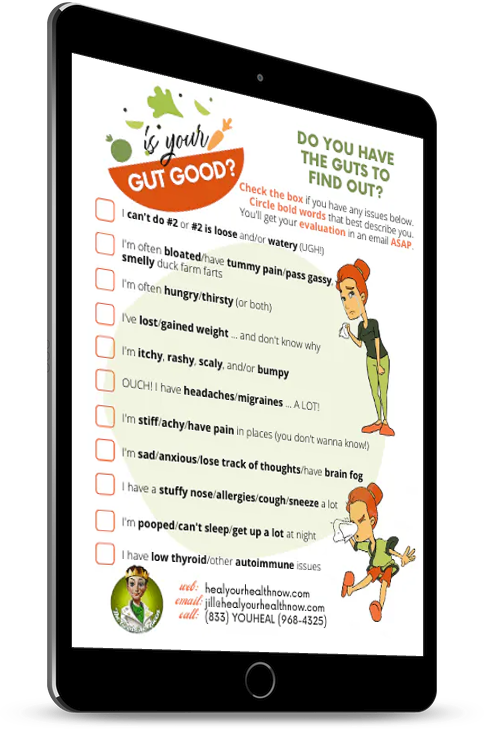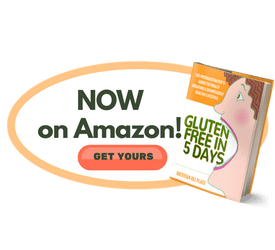 By Dietitian Jill Place
By Dietitian Jill Place
Years ago, when I had just begun my nutrition journey, I ran huge seminars for Harvey and Marilyn Diamond. At the time, they were the authors of the book, Fit for Life. And … at the time, the book was red HOT … and on the list of the 25 most-sold-ever books, along with Gone with the Wind and the Bible.
Harvey was a terrifically animated speaker. And I’ll never forget what he said one night … with lots of body language. “Milk is designed to make a tiny calf become a full-grown cow in less than a year. So … if you want to get REAL big REAL fast … drink milk!”
It took me years and years after that to go Dairy Free. But, if you’ve read my Health Self-Experiment articles, you know that I’m totally into experimenting with different ways that my life can ultimately be better.
So I thought I’d give it a try. And after just a few days, the small patches of eczema that had lived on my face for about 30 years disappeared! Not to mention that I felt better and less stuffed-up … even during high-allergy days here in L.A.
The experiment was a resounding success! So I thought that going Dairy Free was a good thing to do long-term.
Here are some other good reasons to go Dairy Free …
Scientific Reasons to Go Dairy Free
First of all, a 2015 British Medical Journal Study showed that dietary calcium did NOT protect us against bone fractures. It also pooh-poohed calcium supplements, but most, like the Calcium Carbonate that most take, are inorganic, poorly absorbed, and actually pull calcium out of bones. I don’t recommend them myself … there are much better alternatives!
Not only that, dairy milk contains over twenty-five different molecules that can possibly cause allergic reactions. 65% of the world is dairy intolerant, with Asians topping the throng at 90%. I don’t know about you, but I’d steer clear of something that 65% of the world can’t tolerate.
Also, dairy has been linked to conditions like eczema (why am I not surprised … ) and all kinds of digestive disorders (GERD is a huge contender). And symptoms that vary anywhere from itchy, flaky skin to abdominal pain to coughing and throat swelling (got that too!).
The saddest part of the bill-of-goods that we’ve been sold by the dairy industry is what it has done to children. The World Health Organization has studied the problem. And found that as many as 1 in 20 babies suffer from digestive, respiratory, and/or skin problems from dairy or dairy-based products.
Babies may vomit, have diarrhea or skin rashes, colds, and recurrent ear infections among many other symptoms. And formulas are rife with it. Breast milk is best.
But I was of the era where it was frowned upon … I got milk-based formula instead. And have spent years with digestive disorders. What have we done to babies? And to ourselves?
Milk is Actually a Processed Food
When you think about it … milk has been cooked (pasteurization), shook (homogenization), and had stuff added to it (MORE calcium, vitamin D, and, lately, Omega-3s). All of that makes it a highly processed food.
Not to mention the fact that dairy farmers use synthetic hormones (mostly rBST) to stimulate production of another hormone, IGF-1, that boosts milk production up to 20 percent. But the hormones also increase udder infections, infertility, lameness, cystic ovaries, digestive disorders, and many other problems for the cows.
Higher levels of IGF-1 in humans has been linked linked to a statistically significant increase in the risks of prostate, colon, lung, and breast cancers. Not only that, IGF-1, in one study, has been called “the crossroad of the nutritional, inflammatory, and hormonal pathways to frailty“.
Oh … and what about antibiotics? I know that this has been a hotly debated additive for both milk and meat, but even without added antibiotics, hormones make the cows sick. And what do they get to cure them … antibiotics! It’s a vicious cycle.
Antibiotic testing for animals is pretty much ineffective. Screenings are also few, for only a few select antibiotics (when many can be used), and low levels are allowed. But they never tell you that even low levels accumulate within your body.
So … with all this going on … do you really want to do dairy? If not, here’s some easy guidelines to go Dairy Free …
My Dairy Free Guidelines and Substitutions
I found it very easy to go Dairy Free. Back when I started my whole foods journey, we even had to make our own almond milk from a recipe in the vegetarian bible, Ten Talents.
But now there’s SO MANY DAIRY ALTERNATIVES out there that I hardly miss dairy. Of course, these products can also have additives. But they won’t have milk, rBST, or antibiotics.
I’m going to give you the category … then list alternatives. GO FOR IT! But before we do that, let me list ingredients that are “Definitely Dairy” from the great book, Go Dairy Free …
acidophilus milk, ammonium caseinate, butter, butter oil, butter solids, butterfat, buttermilk, buttermilk powder, calcium caseinate, casein, caseinate, cheese, condensed milk, cottage cheese, cream, curds, custard, whey, dry milk powder, dry milk solids, evaporated milk, fat free milk, ghee, goat cheese, goat’s milk, half-and-half, hydrolyzed casein, hydrolyzed milk protein, ice cream, iron caseinate, lactalbumin, lactose, lactulose, low fat milk, magnesium caseinate, malted milk, milk, milk fat, milk powder, milk protein, milk solids, nougat, paneer, potassium caseinate, pudding, recaldate, rennet, sheep cheese, sheep’s milk, sherbet, skim milk, sodium caseinate, sour cream, sour milk solids, sweet whey, sweetened condensed milk, whey (all kinds), whipped cream, whipped topping, whole milk, yogurt, zinc caseinate
I know it’s a lot … but read the above list and see if you can detect these in any of the products you’re using. Because they DO hide. Then consider the following substitutes for …
MILK:
Almond, coconut, soy (not my fave because use is controversial), cashew, hazelnut, rice. These can be found fresh and in tetra paks and there are many, many brands.
I DO like coconut for cream sauces as its high fat content helps with the thickening and texture. But try them all and see which you like with regards to taste and texture (coconut DOES taste vaguely like coconut … but AH LIKE IT!)
YOGURT:
Soy, coconut, almond, cashew … the possibilities are endless. I DO personally like So Delicious, Forager, Silk, and Kite Hill … but, again, experiment with them to find the ones you like. As new brands are appearing all the time.
ICE CREAM:
Again … soy, coconut, almond, cashew … and many, many brands … So Delicious, Coconut Bliss … even Haagen Dasz, and Ben & Jerry’s (can’t leave the Cherry Garcia alone!) have Dairy Free kinds. But I’m more partial to Nada Moo, a coconut milk confection sweetened with agave nectar. It’s a high-glycemic-index sweetener, but a better choice than cane sugar, which is what most of these ice creams yare sweetened with.
CHEESE:
OK … I gotta tell you … these will NEVER taste like the multi-splendiferous perfection of aged fantabulouness. But … if you’re missing cheese on your burger … these are more than adequate stand-ins. And the “just like Parmesan” by Violife … MWAH!
Cheese was the reason that I didn’t go Dairy Free until recently. I just love it! But I’m more than satisfied with the alternatives. Violife is one, and so is So Delicious, Kite Hill (for cream cheese and ricotta substitutes), Follow Your Heart, Teese, and Daiya.
SOUR CREAM:
This was difficult as I’ve never liked them, but Follow Your Heart and Tofutti make them. And I can’t WAIT to try one I’ve just found doing this article … WayFare.
I DO make sour cream by straining coconut milk yogurt in a yogurt strainer overnight in the fridge and adding a little vinegar or lemon juice afterwards. Or blend cashews soaked overnight with vinegar, lemon juice, and sea salt. Or, even more simple, a dollop of Dairy Free yogurt.


Leave a Reply